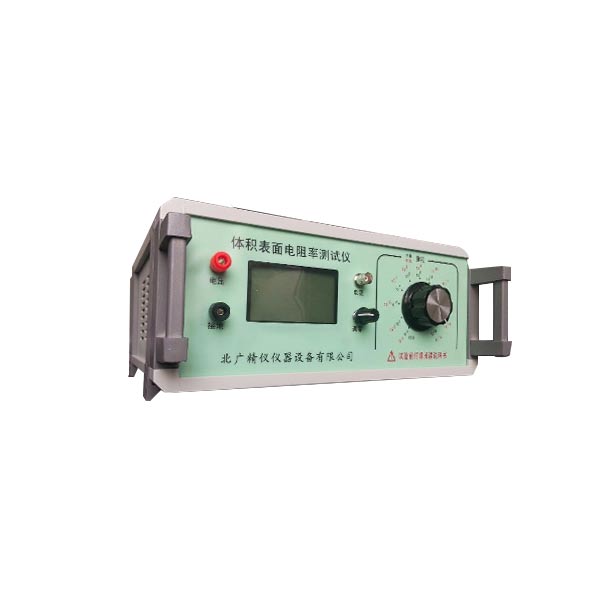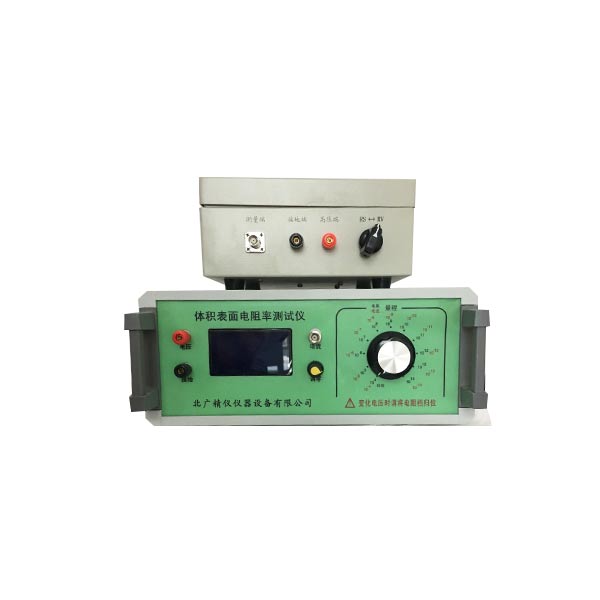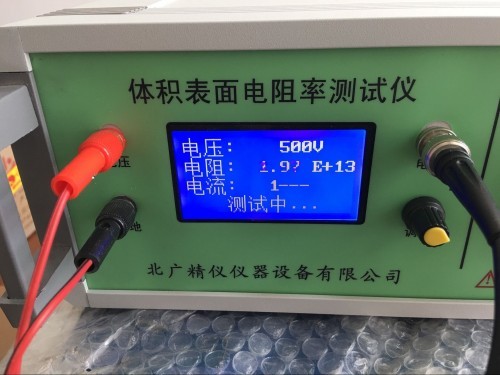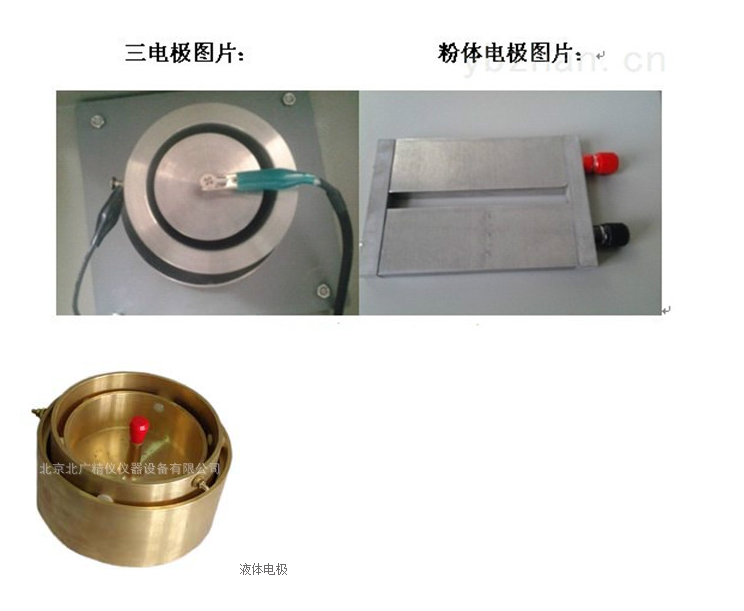
塑料体积电阻率测试仪 什么是体积电阻率?
体积电阻率,是材料每单位体积对电流的阻抗,用来表征材料的电性质。通常体积电阻率越高,材料用做电绝缘部件的效能就越高。通常所说的电阻率即为体积电阻率。
,式中,h是试样的厚度(即两极之间的距离);S是电极的面积,ρv的单位是Ω?m(欧姆?米)。
材料的导电性是由于物质内部存在传递电流的自由电荷,这些自由电荷通常称为载流子,他们可以是电子、空穴、也可以是正负离子。在弱电场作用下,材料的载流子发生迁移引起导电。材料的导电性能通常用与尺寸无关的电阻率或电导率表示,体积电阻率是材料导电性的一种表示方式。
简言之,在绝缘材料里面的直流电场强度与稳态电流密度之商,即单位体积内的体积电阻.
塑料体积电阻率测试仪 主要标准:
GB/T 1410-2006《 固体绝缘材料体积电阻率和表面电阻率试验方法》
ASTM D257-99 《绝缘材料的直流电阻或电导试验方法》
GB/T 2439-2001《硫化橡胶或热塑性橡胶 导电性能和耗散性能电阻率的测定》
GB/T 10581-2006《绝缘材料在高温下电阻和电阻率的试验方法》
GB/T 1692-2008《硫化橡胶绝缘电阻率的测定》
GB/T 12703.4-2010《纺织品 静电性能的评定 第4部分:电阻率》
GB/T 10064-2006《测定固体绝缘材料绝缘电阻的试验方法》
材料说明
A、通常,绝缘材料用于电气系统的各部件相互绝缘和对地绝缘,固体绝缘材料还起机械支撑作用.一般希望材料有尽可能高的绝缘电阻,并具有合适的机械、化学和耐热性能.
B、体积电阻班组可作为选择绝缘材料的一个参数,电阻率随温度和湿度的京戏化而显著变化.体积电阻率的测量常常用来检查绝缘材料是否均匀,或都用来检测那些能影响材料质量而又不能作其他方法检测到的导电杂质.
C、当直流电压加到与试样接触的两电极间时,通过试样的电流会指数式地衰减到一个稳定值.电流随时间的减小可能是由于电介质极化和可动离子位移到电极所致.对于体积电阻小于10的10Ω.m
的材料,其稳定状态通常在1min内达到.因此,要经过这个电化时间后测定电阻.对于电阻率较高的材料,电流减小的过程可能会持续几分钟、几小时、几天,因此需要用较长的电化时间.如果需要的话,可用体积电阻率与关系来描述材料的特性.
D、由于体积电阻总是要被或多或少地包括到表面电阻的测试中去,因些近似地测量表面电阻,测得的表面电阻值主要反映被测试样表面污染的程度.所以,表面电阻率不是表面材料本身特性的参数,而是一个有关材料表面污染特性的参数.
当表面电阻较高时,它常随时间以不规则的方式变化.测量表面电阻通常都规定11min的电化时间.
符合标准及适用范围:

完全符合国家标准GB1410-2006固体电工绝缘材料绝缘电阻、体积电阻系数和表面电阻试验方法,ASTM D257绝缘材料的直流电阻或电导试验方法 等标准要求。
本仪器配不同的测量电极(夹具)可以测量不同材料(固体、粉体或液体)的体积电阻率和表面电阻率或电导率。适用于橡胶、塑料、薄膜、及粉体、液体、及固体和膏体形状的各种绝缘材料体积和表面电阻值的测定。本仪器除能测电阻外,还能直接测量微弱电流。
技术指标
1.电阻测量范围:0.01?10 4Ω ~1?10 18Ω。
2.电流测量范围为: 2?10-4A~1?10-16A
3.双表头显示: 3.1/2位LED显示
4.内置测试电压:10V、50V、100V、250、500、1000V
5.准确度:准确度优于下表
量程有效显示范围20~30℃RH<80%
104 0.01~19.99 5%
105 0.01~19.99 5%
106 0.01~19.99 5%
107 0.01~19.99 5%
108 0.01~19.99 5%
109 0.01~19.99 5%

1010 0.01~19.99 5% 2字
1011 0.01~19.99 5% 2字
1012 0.01~19.99 5% 5字
1013 0.01~19.99 10% 5字
1014 0.01~19.99 10% 5字
1014以上0.01~19.99 10-15% 5字
超出有效显示范围时误差有可能增加,测试电流准确度与电阻相同,测试电压准确度为10%
6使用环境:温度:0℃~40℃,相对湿度<80%
7机内测试电压: 10/50/100/250/500/1000V任意切换
8.供电形式: AC 220V,50HZ,功耗约5W
9.仪器尺寸: 285mm?245mm?120 mm
10.质量:约2.5KG
11 测试电压有六种选择之多DC10V、50V、100V、250V、500V、1000V;
12 使用操作简便,在任何电阻量程和测试电压下均直接读显示数字结果,
免去要乘以一个系数的麻烦,使测量超高电阻就如用万用表测量普通电阻样简便。
What is volume resistivity?
Volume resistivity is the impedance of a material to current per unit volume, used to characterize the electrical properties of the material. The higher the volume resistivity, the more effective the material is as an electrical insulation component. The resistivity commonly referred to is the volume resistivity.
In the formula, h is the thickness of the sample (i.e. the distance between the two poles); S is the area of the electrode, and the unit ofρv isΩ?m (ohm meters).
The conductivity of materials is due to the presence of free charges inside the material that transfer current, which are commonly referred to as charge carriers. They can be electrons, holes, or positive and negative ions. Under the action of a weak electric field, the migration of charge carriers in the material causes conductivity. The conductivity of materials is usually represented by resistivity or conductivity that is independent of size, and volume resistivity is a way of expressing the conductivity of materials.
In short, the quotient of the DC electric field strength and steady-state current density in insulating materials is the volume resistance per unit volume
Main standards:
GB/T 1410-2006 "Test Method for Volume and Surface resistivity of Solid Insulation Materials"
ASTM D257-99 "Test Method for DC Resistance or Conductivity of Insulation Materials"
GB/T 2439-2001 "Determination of Electrical Conductivity and Dissipation Properties of Vulcanized Rubber or Thermoplastic Rubber"
GB/T 10581-2006 "Test method for resistance and resistivity of insulating materials at high temperatures"
GB/T 1692-2008 "Determination of Insulation Resistance of Vulcanized Rubber"
GB/T 12703.4-2010 "Evaluation of electrostatic properties of textiles - Part 4: Electrical resistivity"
GB/T 10064-2006 "Test Method for Determining Insulation Resistance of Solid Insulation Materials"
Material Description
A. Usually, insulation materials are used for mutual insulation and ground insulation of various components in electrical systems, and solid insulation materials also serve as mechanical support Generally, it is desirable for materials to have the highest possible insulation resistance and appropriate mechanical, chemical, and heat resistance properties
B. The volume resistance group can be used as a parameter for selecting insulation materials, and the resistivity varies significantly with temperature and humidity The measurement of volume resistivity is often used to check whether the insulation material is uniform, or to detect conductive impurities that can affect material quality but cannot be detected by other methods
C. When a direct current voltage is applied between the two electrodes in contact with the sample, the current passing through the sample will exponentially decay to a stable value The decrease in current over time may be due to dielectric polarization and the displacement of movable ions to the electrode For 10Ω?m with a volume resistance less than 10
The material typically reaches a stable state within 1 minute Therefore, the resistance should be measured after this electrification time For materials with high resistivity, the process of current reduction may last for several minutes, hours, or days, thus requiring a longer electrochemical time If necessary, volume resistivity and its relationship can be used to describe the properties of materials
D. Due to the fact that volume resistance is always included to a greater or lesser extent in surface resistance testing, surface resistance is approximately measured, and the measured surface resistance value mainly reflects the degree of surface contamination of the tested sample So, surface resistivity is not a parameter of the surface material itself, but a parameter related to the surface pollution characteristics of the material
When the surface resistance is high, it often changes irregularly over time The measurement of surface resistance usually requires an electrochemical time of 11 minutes
Compliance with standards and scope of application:
Fully comply with the national standard GB1410-2006 Test Methods for Insulation Resistance, Volume Coefficient of Resistance, and Surface Resistance of Solid Electrical Insulation Materials, as well as ASTM D257 Test Methods for DC Resistance or Conductivity of Insulation Materials.
This instrument, equipped with different measuring electrodes (fixtures), can measure the volume resistivity, surface resistivity, or conductivity of different materials (solids, powders, or liquids). Suitable for measuring the volume and surface resistance values of various insulation materials in the shapes of rubber, plastic, film, powder, liquid, solid, and paste. This instrument can not only measure resistance, but also directly measure weak currents.
Technical indicators
1. Resistance measurement range: 0.01?10 4Ω~1?10 18Ω.
2. The range of current measurement is: 2?10-4A~1?10-16A
3. Dual header display: 3.1/2 LED display
4. Built in test voltage: 10V, 50V, 100V, 250, 500, 1000V
5. Accuracy: Accuracy is better than the following table
Effective display range of range: 20-30℃RH<80%
104 0.01~19.99 5%
105 0.01~19.99 5%
106 0.01~19.99 5%
107 0.01~19.99 5%

108 0.01~19.99 5%
109 0.01~19.99 5%
1010 0.01~19.99 5% 2 words
1011 0.01~19.99 5% 2 words
1012 0.01~19.99 5% 5 words
1013 0.01~19.99 10% 5 words
1014 0.01~19.99 10% 5 words
Above 1014, 0.01~19.99, 10-15% 5 words
When the effective display range is exceeded, the error may increase. The accuracy of the test current is the same as that of the resistance, and the accuracy of the test voltage is 10%
6. Operating environment: Temperature: 0℃~40℃, relative humidity<80%
7. Internal testing voltage: 10/50/100/250/500/1000V can be switched freely
8. Power supply form: AC 220V,50HZ,Power consumption is about 5W
9. Instrument size: 285mm?245mm?120mm
10. Quality: Approximately 2.5KG
There are six options for testing voltage: DC10V, 50V, 100V, 250V, 500V, and 1000V;
Easy to use and operate, it can directly read and display digital results at any resistance range and test voltage,
Eliminating the hassle of multiplying by a coefficient, making measuring ultra-high resistance as easy as measuring ordinary resistance with a multimeter.
业务咨询:932174181 媒体合作:2279387437 24小时服务热线:15136468001 盘古机械网 - 全面、科学的机械行业免费发布信息网站 Copyright 2017 PGJXO.COM 豫ICP备12019803号